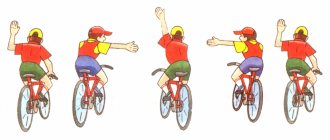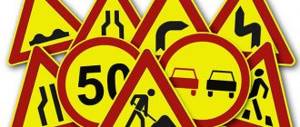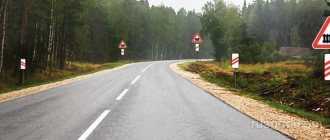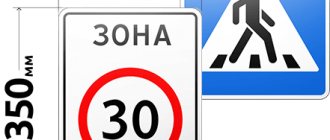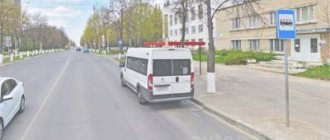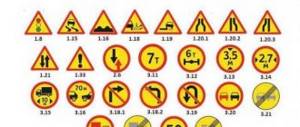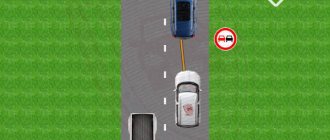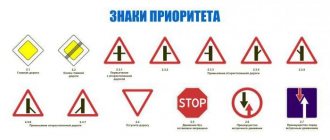2nd article of 4 in the series Priority Road Signs
Priority road signs
- Priority road signs
- Group of signs “Main Road” 2.1-2.3.7
- Priority signs “Give way” 2.4 and 2.5
- Oncoming traffic priority signs 2.6, 2.7
The first group of traffic rules priority signs are road signs related to the concept of “Main Road”.
In accordance with the definition given in paragraph 1.2 of the traffic rules, the main road is a road marked with signs 2.1, 2.3.1 - 2.3.7 or 5.1, in relation to the one being crossed (adjacent), or a road with a hard surface (asphalt and cement concrete, stone materials and the like) in relation to the dirt road, or any road in relation to exits from adjacent territories.
Since the topic of the article is priority signs, we will limit ourselves to signs 2.1, 2.2, 2.3.1 - 2.3.7. Sign 5.1 “Highway” is discussed in the article Signs of special requirements 5.1 - 5.4.
Sign 2.1 “Main Road”
Road sign 2.1 “Main Road” indicates a section of the road on which priority is given to travel through unregulated intersections.
This means that any traffic participant who approached an unregulated intersection on the main road has the right to pass through the intersection first in relation to other participants who approached this intersection on a secondary road.
In populated areas, the “Main Road” sign is installed in front of each intersection on the main road. If the intersecting road of an uncontrolled intersection has no more than four lanes, and the main road runs in a straight direction, it is allowed to install sign 2.1 of reduced size.
Intersections are formed with both the intersecting and the adjacent road (T-shaped, U-shaped).
In populated areas, before a secondary road joins the main road, it is allowed not to install the “Main Road” sign on the side opposite the junction. This means that in a populated area, before an intersection with an adjacent secondary road, sign 2.1 can be installed in front of the intersection only on the side of the road junction.
If at an intersection the main road changes its direction, as well as before intersections with a complex layout, the “Main Road” sign is used with plate 8.13 “Direction of the Main Road”. Sign 8.13 shows a schematic diagram of the intersection. The thick line symbolizes the main road, thin lines represent secondary roads.
When the main road at an intersection turns and you need to turn, you need to remember the requirement of paragraph 8.5 of the traffic rules - take a position on the roadway corresponding to the direction of the turn. For more information about the rules for turning at such intersections, see the article Exiting and turning from the main road.
If you are driving through an intersection in the forward direction, at which the main road turns right (exit onto a secondary road), you must remember the requirement of paragraph 13.10 of the traffic rules - to give way to vehicles that are turning towards you on the main road. This traffic situation is discussed in the article If the traffic light at an intersection does not work.
In populated areas, sign 2.1 with plate 8.13 is installed in front of the intersection, and outside populated areas - first at a distance of 150 - 300 meters before the intersection and in front of the intersection.
In the case where an intersection has several crossings of roadways, the “Main Road” sign is installed in front of all intersections at which there may be an ambiguous determination of the primacy of roads.
At controlled intersections, sign 2.1 “Main Road” is placed in close proximity to the main traffic light, usually on its support. A traffic light operating in the “red-yellow-green” mode cancels the priority signs.
The rules for driving through an unequal intersection, in particular, driving along the main road, including answers to some questions from readers, are set out in the Main Road series of articles.
Rules for driving through unregulated intersections
Rule 1 The one who approaches the intersection along the main road has the right of way. But when turning left or making a U-turn at an uncontrolled intersection, you need to give way to oncoming vehicles that are moving along an equivalent road in the “straight” or “right” direction.
We recommend reading: What do they give for the first child in 2021 in Chuvashia
In this case, you need to significantly reduce your speed, drive almost close to the intersection and look again at all its corners. If any of these signs do appear, you need to quickly make a decision: either stop or move on. Well, if you are finally convinced that there are no priority signs here, it means that in front of you is an intersection of equivalent roads and the “interference on the right” rule applies there.
Sign 2.2 “End of the main road”
The "End of Main Road" road sign indicates that the road on which priority has been granted for uncontrolled intersections has ended. Sign 2.2 is installed at the end of the road section where it loses its main status.
If the main road ends before an intersection, then sign 2.2 “End of the main road” is placed:
- in populated areas - either together with sign 2.4 “Give way” or 2.5 “Driving without stopping is prohibited”, or 25 meters from the intersection; a preliminary sign 2.2 with a plate 8.1.1 “Distance to object” may be installed.
- outside populated areas - on the same support with a preliminary sign 2.4 “Give way”, which is installed with a sign 8.1.1 or 8.1.2 “Distance to the object”; sign 2.2 can be re-installed with sign 2.4 or 2.5.
Is an intersection with a dirt road a crossroads? Found the answer in the traffic rules
Outside the city, an asphalt road often intersects with a dirt road, as well as roads with other types of surfaces (for example, gravel). Many drivers do not pay much attention to this, because they believe that the one on the asphalt always has priority. But in reality this is not entirely correct. Let's figure out in what situations a road covered with asphalt may not be the main one in relation to a road with another type of surface.
First, let's turn to the rules of the road and carefully consider the definitions of what an intersection is and which road can be considered the main one. An intersection is the intersection, junction or branch of roads that are at the same level. Nothing is said about the type of surface, therefore, the intersection of asphalt and dirt roads is also considered an intersection.
If a secondary road intersects or does not adjoin a main road at a right angle, on the signs Intersection with a minor road, Junction with a secondary main road (1.56, c) this may be shown at the appropriate angle depending on the configuration of the intersection.
1.1. Apparently, the scooter did not have the right of way through the intersection. This means that you should not have given way to him. Part 2 Art. 12.13 Code of Administrative Offenses of the Russian Federation and Art. 13.4 Traffic regulations are not applicable here. Otherwise, everything depends on the traffic police, what else they come up with there. But in any case, the scooter driver will have the right to recover from you compensation for damage caused to health and moral damage.
We recommend reading: Lists for obtaining apartments from dilapidated housing in Samara 2021
Main road traffic rules or the main thing you need to know about it
Almost always, the “main road” sign is installed and regulates the priority of traffic for a separate section or the entire road from the installation site to the place where the sign that terminates its effect is installed, that is, to the installed “end of the main road” sign.
To designate a main road, most countries use a sign in the form of a regular diamond with 90-degree angles, white, with a yellow or sometimes orange border around the perimeter. In some countries, an additional letter qualifier is used, corresponding to the term "Main Road". The installation of this sign is usually applied directly to the road to which the priority position is assigned.
Main road traffic rules or the main thing you need to know about it
Almost always, the “main road” sign is installed and regulates the priority of traffic for a separate section or the entire road from the installation site to the place where the sign that terminates its effect is installed, that is, to the installed “end of the main road” sign.
It is important for the driver to correctly navigate the intersection of the main road and the secondary road and, in strict compliance with traffic rules, make a maneuver; according to the conditions of priority, the following, largely standard situations may most often arise:
We recommend reading: State duty when filing a claim against common shared property
At the same time, the concept of “Give way (do not interfere)” is a very insidious one. Some drivers believe that they must stop when asked to give way. It is not right. If we have no one to give way to, then we shouldn’t stop.
Let's be honest, there is no such concept in the traffic rules. It is a product of the everyday language of instructors, drivers and traffic police inspectors. However, the “right hand” rule is a universal principle of traffic rules, which also concerns the problem of priority in traffic. That is why we, by our own willful decision, introduce such a concept into our presentation (do not wait for commentary on section 8 of the traffic rules).
Rule for exiting from a secondary road to the main one
– Articles – Rule for exiting from a secondary road to the main one
In the traffic rules, using the terms main and secondary roads, priorities are regulated when motorists move through intersections. To determine which vehicle has the right of way, drivers must clearly understand and differentiate these concepts.
What is it? The approach of the main road is symbolized by a special road sign. The road will always be the main one if it has a hard surface, and those crossing it are unpaved. Any roads that serve as exits from residential areas (for example, from a yard) are considered secondary.
There can be only one main road; all cars on it have priority right of passage. Secondary roads are those that intersect or adjoin the main one.
By definition, a main road has a beginning and an end; the same road can be first a main road and then a secondary one. But it never ends at the crossroads.
First, the green and yellow cars will pass, after which the blue one will be able to make its maneuver: drive straight, turn left or right, and only after that will you be able to make the maneuver, and your trajectories will not intersect.
Secondary road at the intersection to the right Let us now consider another intersection at which the secondary road goes to the right.
The corresponding signs will indicate this - see the picture to clearly understand everything.
The secondary road at the intersection goes to the right. Right turn with the secondary one. In such a situation, when leaving the secondary road at the intersection with the main road to turn right, you in a white car will need to give way to green and blue cars if their trajectories intersect with yours.
Exit to the main road. left turn
- a driver moving straight does not give way to anyone;
- the driver of a tram or trackless vehicle turning right gives way only to pedestrians and cyclists who continue moving straight;
- a driver turning left gives way to oncoming vehicles (including those making a right turn), as well as to pedestrians continuing to move straight;
- The driver making a U-turn gives way only to oncoming vehicles.
Driver's actions when switching a traffic light Having entered an intersection on a permissive traffic light (including a flashing green one), the driver must clear the intersection, even if the traffic light has switched to a prohibiting signal, provided that there are no stop lines on his route through the intersection.
Exit to the main road
Before you go in the right direction, you must:
- when turning right, give way to pedestrians and cyclists who cross the road to your right;
- when turning left - give way to oncoming vehicles moving straight and to the right (that is, in the same direction you want to turn), as well as to pedestrians crossing the road to your left;
- when turning - to oncoming vehicles and those approaching the intersection from the left side (in the process of turning, such vehicles will also become oncoming traffic);
- when driving straight, you can leave the intersection without hindrance if you entered it correctly earlier;
- turning left of two vehicles moving from opposite directions can be performed simultaneously, provided that both drivers choose non-intersecting trajectories and maintain a safe lateral interval.
Rules for crossing intersections
The road on the left is clear and you are about to take the secondary exit, but at a certain moment the driver of the red car starts to overtake a truck. Since you are still in the secondary lane, the red car has an advantage according to paragraph 13.9 of the traffic rules, and according to article 11.4 it is not prohibited from overtaking on a specific section of the road.
The car went to overtake While going to overtake a truck, the driver of a red car drives into oncoming traffic and then an unsuspecting driver of a white car drives out to meet him. Of course, this leads to an emergency situation.
Even if instead of a broken line there is a solid line on the road, you need to be more careful when entering the main road, because the driver of a red car can violate traffic rules and overtake against the rules.
How to determine the main and secondary roads?
Attention
This sign can most often be seen at uncontrolled intersections. A car driving under such a sign has an advantage over other road users.
- "The end of the main road." Such a sign is located immediately before the intersection and means that the previously existing advantages are no longer available.
- “Intersection with a minor road” and “Adjacent to a minor road”.
These related signs are mainly installed outside the populated area. They mean that motorists at the intersection will have priority over vehicles traveling along the road being crossed.
- "Give way." Unlike the above signs that give priority, it, on the contrary, means that motorists must give way to vehicles moving on the main road.
- “Driving without stopping is prohibited.”
To ensure that drivers do not cause interference, they are required to take all possible measures to avoid an accident. For example, if there is no priority, you should refuse to resume, start or continue the movement. This rule has several nuances:
- If several roads with only asphalt or only dirt surfaces intersect, in the absence of special signs, then the rights are considered equivalent and no one has an advantage.
- If there is a paved section on the dirt road before the intersection with the main one, it still remains a secondary road.
- If drivers can determine the order of traffic lights, all roads are equal, even if there were previously identifying signs.
Cars without the right of way are prohibited from entering the intersection if there is a traffic jam and they interfere with the smooth movement of other cars.
Rules for driving through unregulated intersections
Those drivers who drive on the main road, especially in a “solid traffic jam,” should be patient and show complicity, because any of them may find themselves in a similar situation when they need to leave, but no one is letting them through.
Those driving from a secondary road onto the main one, in turn, should be very careful, regardless of which direction the turn is made: right or left.
In the previous article Turning right from the third lane, we looked at an accident that occurred due to the fault of a driver who was changing lanes. There is always a certain risk associated with changing lanes, in general, as in the traffic situation, which we will consider in our next article.
Be attentive and mutually polite! Navigation through the series of articlesWill I have time to get through? - But you won’t have time! This may be interesting If the field under the title is empty, AdBlock is probably enabled in your browser.
road to traffic rules
Roundabout intersections Driving through a roundabout intersection follows the same rules that apply to other intersections.
In the absence of priority signs, the intersection is equivalent, and drivers are guided by the rule of interference on the right.
When there are “Give Way” signs, drivers entering an intersection give way to those already driving in the circle.
Driving through controlled intersections At controlled intersections, the traffic order is determined by the signals of the traffic light or traffic controller.
If the traffic controller’s signals contradict the traffic light signals and the instructions of the road signs, then you must be guided by the traffic controller’s requirements.
If traffic light signals contradict the requirements of road signs 2.1, 2.4 or 2.5, then you must be guided by the traffic light.
The permitting signal from a traffic light or a traffic controller allows you to enter a controlled intersection.
Driving through intersections
Signs indicating a secondary road are also placed in front of an unregulated intersection.
Before entering the main road, drivers must make sure that they are interfering with the traffic of crossing vehicles.
The meaning of the road sign means that drivers moving along it have priority over road users arriving from secondary roads.
This is necessary to avoid serious accidents. It is important to know that if there is a traffic light or traffic controller at the intersection, then the effect of the sign is canceled.
Rules for exiting from a secondary road to the main one
What does it mean to “give in”? Do not interfere with the movement of vehicles moving on the main road, i.e.
Exit to the main road A car leaving a secondary road or from a yard is obliged to give way to vehicles moving along the main road, and from both directions (clause 13.
9 and 8.3 traffic regulations). Drivers driving on the main road have priority in traffic.
Important
Moreover, at uncontrolled intersections they are allowed to overtake. Based on the situations in the videos, it turns out that from the point of view of traffic regulations, these drivers did not violate anything. Leaving the adjacent territory For motorists, there are many controversial issues regarding traffic rules.
Moreover, this applies to both experienced and novice drivers. Even if it seems to you that you have a perfect understanding of traffic rules, changes in the rules can raise many questions.
One of these situations is presented in the videos. Turning left from a minor road Turning left when leaving the yard First, let's comment on these traffic situations in the video from the point of view of traffic regulations.
A car leaving a secondary road or a yard is obliged to give way to vehicles moving on the main road, and from both directions (clauses 13.9 and 8.3 of the traffic rules). Drivers driving on the main road have priority in traffic.
Moreover, at uncontrolled intersections they are allowed to overtake. Based on the situations in the videos, it turns out that from the point of view of traffic regulations, these drivers did not violate anything. But, nevertheless, the collision occurred.
We will leave who is more guilty in these situations to the discretion of the inspector, and we ourselves will try to figure out why this happens.
Source: https://11-2.ru/pravilo-vyezda-s-vtorostepennoj-dorogi-na-glavnuyu/

